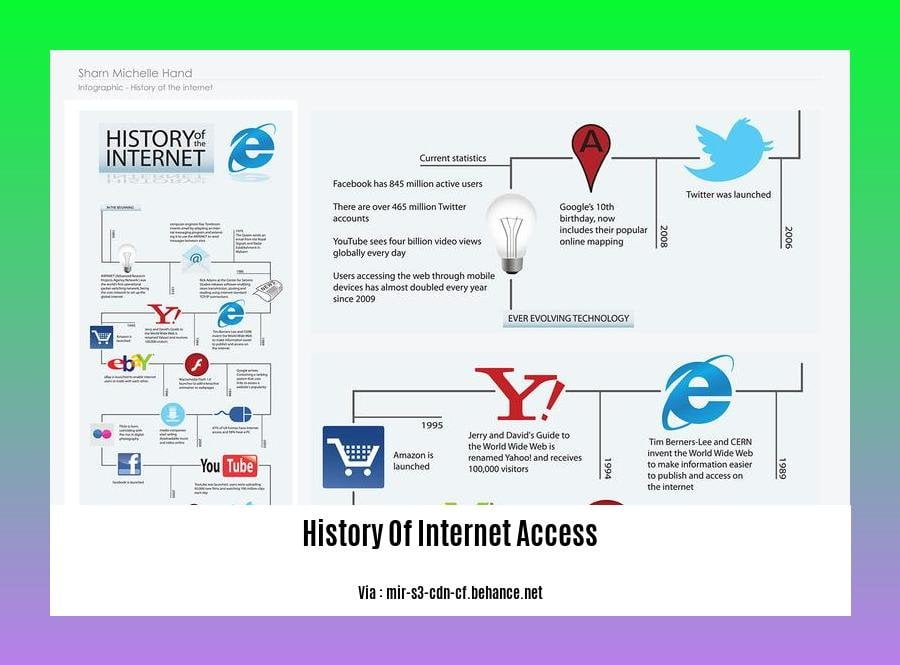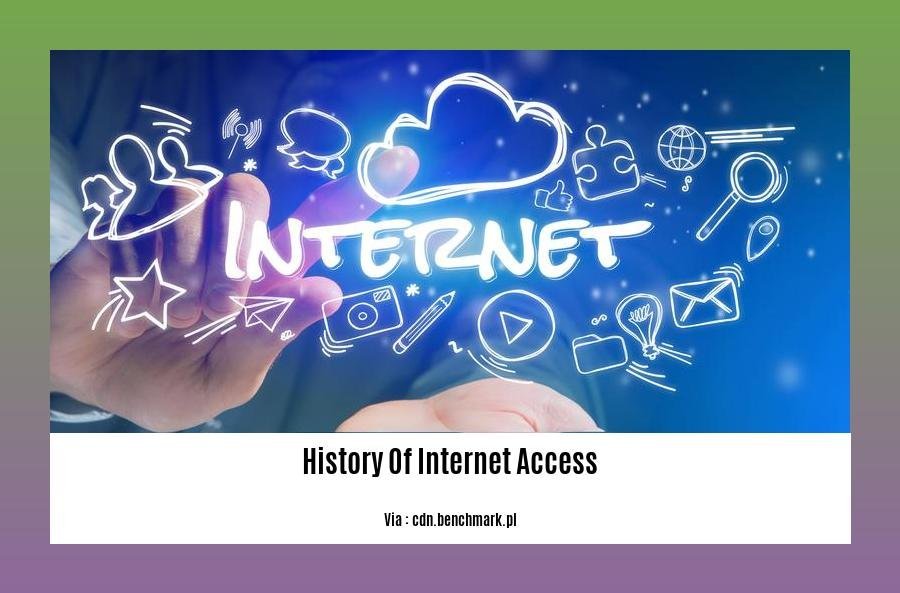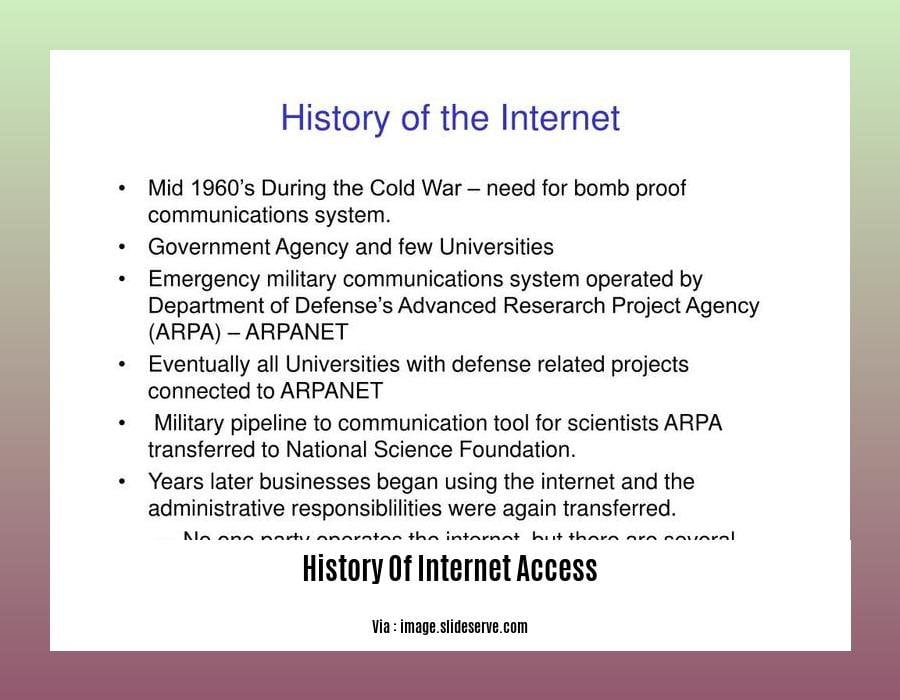Embark on an enlightening journey through the annals of internet access, a transformative odyssey that has indelibly reshaped the modern world. From the humble beginnings of dial-up modems to the radical upheaval brought about by broadband and mobile internet, [Unveiling the History of Internet Access: A Journey from Dial-Up Modems to Broadband Revolution] meticulously chronicles the technological advancements, regulatory shifts, and cultural impact that have shaped our digital landscape. Dive into a comprehensive exploration of the forces that have propelled us into the era of instant connectivity and limitless information, while peering into the horizon to glimpse the challenges and opportunities that lie ahead.
Key Takeaways:
Internet’s origins stem from efforts to connect computer networks.
TCP/IP, a set of communication protocols, arose in the 1970s.
The 1990s marked rapid Internet growth and the rise of the World Wide Web.
The 21st century brought global Internet expansion and new technologies like social media.
The Internet has revolutionized communication, learning, work, and business.
History of Internet Access

In the ever-evolving digital landscape, the history of internet access has played a pivotal role in shaping our modern world. From the humble beginnings of dial-up modems to the ubiquitous presence of broadband and mobile internet, this journey has transformed the way we communicate, learn, work, and interact, leaving an indelible impact on societies worldwide.
Early Days: Navigating the Dial-Up Era
The introduction of dial-up modems in the 1990s marked a significant milestone in the history of internet access, providing users with their first taste of the World Wide Web. These modems connected computers to the internet over telephone lines, emitting the iconic screeching and buzzing sounds that became synonymous with the era. While dial-up internet offered a glimpse into the vast possibilities of the digital world, it was characterized by slow speeds and frequent disconnections, leaving users yearning for a faster and more reliable connection.
Broadband Revolution: Ushering in a New Era of Connectivity
The advent of broadband internet in the early 2000s revolutionized the way we accessed the internet. This high-speed connection, enabled by technologies such as DSL, cable, and fiber optics, brought forth a paradigm shift in internet usage. Broadband internet opened doors to seamless streaming of videos and music, online gaming, and real-time video conferencing, transforming the internet from a mere information-sharing platform into an immersive and interactive experience.
Mobile Internet: Connectivity at Your Fingertips
The introduction of smartphones and tablets marked another watershed moment in the history of internet access, ushering in the era of mobile internet. With the proliferation of wireless networks, users gained the freedom to stay connected anytime, anywhere. Mobile internet facilitated the rise of social media, location-based services, and mobile applications, blurring the boundaries between the physical and digital worlds.
Challenges and Opportunities: Shaping the Future of Internet Access
While the history of internet access is marked by remarkable progress, significant challenges persist. The digital divide, referring to the gap between those with and without internet access, remains a pressing concern, particularly in rural and underserved areas. Additionally, issues of internet censorship, net neutrality, and online privacy continue to spark debates and regulatory actions around the world.
The future of internet access holds both challenges and opportunities. As technology continues to advance, we can anticipate faster speeds, increased bandwidth, and more sophisticated applications. The Internet of Things (IoT) and artificial intelligence (AI) are poised to further transform the way we interact with the internet, creating new possibilities for automation, connectivity, and data analysis.
As we delve into the history of internet access, we gain a profound appreciation for the journey that has brought us to this point. From the early days of dial-up modems to the ubiquitous presence of broadband and mobile internet, the internet has evolved from a niche technology to an essential utility, reshaping societies and economies worldwide. As we navigate the challenges and embrace the opportunities that lie ahead, we can anticipate an even more interconnected and digitally empowered future.
Have you always wanted to know the history of the internet and wifi? Click here to read about its vast origins and the subsequent impact on society!
Are you interested in learning more about the History Of The Internet And Social Media? Read more to know how the internet evolved from a scientific concept to a global phenomenon that has transformed communication, society, and the world.
Are you a fan of technology? Read this article about the History Of The Internet In The 2000s and get to know all about the major events that happened, including the dot-com bubble, the rise of social media, and the widespread adoption of mobile devices.
For those who want to learn more about the History Of The Internet Wikipedia, this article provides detailed information about the founding of Wikipedia, its history, governance, and impact on the internet and society.
Do you want to understand the History Of The Internet In A Nutshell and its evolution over the years? Uncover the timeline of the World Wide Web, from its inception to its current state, and learn how it has revolutionized the way we communicate, work, and interact with the world.
Impact on society: Communication, commerce, education, and entertainment

The internet has revolutionized how we communicate, do business, learn, and entertain ourselves. In a world where connectivity is no longer a luxury but a necessity, here’s how the internet has woven itself into the fabric of society.
1. Communication:
The internet has brought the world closer, making it easier than ever to connect with family and friends both near and far. Whether it’s through social media platforms, messaging apps, or video conferencing, the internet has bridged geographical gaps and fostered global communities.
2. Commerce:
From online shopping to e-commerce giants, the internet has transformed the way we buy and sell goods. It has empowered entrepreneurs, enabling them to reach customers beyond their physical storefronts, and created a global marketplace for buyers and sellers.
3. Education:
The internet has democratized access to education, providing countless opportunities for people to learn, upskill, and pursue higher education. Online courses, virtual classrooms, and educational resources have broken down traditional barriers to learning, making education accessible to individuals regardless of their location or circumstances.
4. Entertainment:
The internet has become an endless source of entertainment. From streaming platforms to social media, we can access a vast array of movies, TV shows, games, and music at our fingertips. The internet has fundamentally changed how we consume entertainment, providing a 24/7, on-demand experience.
Key Takeaways:
The internet has transformed communication, enabling instant and seamless connections across the globe.
The internet has revolutionized commerce, creating e-commerce platforms and empowering entrepreneurs to reach a global audience.
The internet has democratized access to education, providing online courses, virtual classrooms, and a wide range of educational resources.
The internet has become a powerhouse of entertainment, offering streaming platforms, social media, and a vast array of digital content.
Sources:
The impact of the internet on society: A global perspective
Society and the Internet
Challenges and Controversies: Digital Divide, Internet Censorship, and Online Safety
The internet has become an integral part of our lives, yet challenges and controversies continue to surround its accessibility and usage. Let’s delve into these issues that have shaped the landscape of internet access.
Digital Divide: A Persistent Global Issue
The digital divide refers to the gap between those who have access to digital technologies and those who don’t. The divide persists globally, with disparities in internet connectivity, affordability, and digital literacy.
Internet Censorship: A Threat to Freedom of Expression
In many countries, internet censorship is a reality. Governments restrict access to certain websites, content, and online platforms, often in an attempt to control information and suppress dissent. This poses a threat to freedom of expression and the free flow of information.
Online Safety: Navigating a Complex Digital World
The internet offers a vast space for communication, learning, and entertainment, but it also harbors risks. Cyberbullying, online scams, and the spread of misinformation are among the concerns that raise questions about online safety and privacy.
Key Takeaways:
Digital Divide: The digital divide persists, leading to disparities in access to digital technologies and the internet.
Internet Censorship: In many countries, internet censorship is a reality, posing a threat to freedom of expression and the free flow of information.
Online Safety: The internet offers a vast space for communication, learning, and entertainment, but also harbors risks such as cyberbullying, online scams, and the spread of misinformation.
Relevant URL Sources:
[Freedom on the Net 2021: The Global Drive to Control Big Tech](
Future prospects and ongoing developments
Have you ever wondered how far we’ve come in terms of internet access? Join us as we delve into the exciting world of internet history, uncovering the evolution of internet connectivity over the years. From the days of dial-up modems to the widespread adoption of broadband and mobile internet, we’ll take a journey through the technological advancements that have shaped our online experiences.
The Dawn of Dial-Up Modems: A Journey into the Past
In the early 1990s, the internet was in its infancy, and dial-up modems reigned supreme. These noisy contraptions connected us to the digital world at a snail’s pace, making it a challenge to load even simple web pages. Yet, this was the gateway that opened up a whole new realm of possibilities.
The Broadband Revolution: A Leap into the Fast Lane
The early 2000s ushered in a new era of internet connectivity with the arrival of broadband internet. DSL, cable, and fiber optic technologies brought blazing-fast speeds, allowing us to stream videos, play online games, and engage in real-time video conferencing. This technological leap revolutionized the way we communicate, work, and play.
Mobile Internet: The World in Your Pocket
Smartphones and tablets changed the game completely. With the proliferation of wireless networks, mobile internet became a game-changer. Social media, location-based services, and mobile applications brought the internet to our fingertips, transforming the way we stay connected and interact with the world around us.
The Road Ahead: Embracing the Future prospects and ongoing developments****
The internet is still in its adolescence, and the future holds endless possibilities. Quantum computing, advanced AI, and decentralized networks are just a few of the emerging technologies that could reshape the online landscape. These innovations have the potential to bring about transformative changes in the way we access and utilize the internet, offering even faster speeds, more secure connections, and enhanced user experiences.
Key Takeaways:
- Broadband revolutionized internet access, enabling high-speed connectivity and transforming our digital experiences.
- Mobile internet brought the internet to our fingertips, changing the way we interact with the world.
- Quantum computing, AI, and decentralized networks hold the potential to redefine the internet landscape.
Relevant Sources:
- Pew Research Center
- Popular Mechanics
FAQ
Q1: What were the primary factors driving the rapid growth of the Internet in the 1990s?
A1: The key factors contributing to the rapid growth of the Internet in the 1990s include the development of the World Wide Web, the emergence of web browsers, and increased accessibility through dial-up modems.
Q2: How has the Internet impacted society, and what are some of its broader implications?
A2: The Internet has profoundly impacted society, transforming communication, education, business operations, and access to information. It has also raised concerns over privacy, security, and the spread of misinformation.
Q3: What are the significant challenges associated with the digital divide, and what strategies can be employed to address it?
A3: The digital divide refers to the disparity in access to digital technologies and the Internet. Strategies to address this challenge include infrastructure development, policy reform, public-private partnerships, expanding broadband connectivity, promoting digital literacy, and addressing affordability issues.
Q4: What are the potential disruptors that could reshape the future of the Internet, and how can we navigate these changes responsibly?
A4: Potential disruptors that could redefine the digital landscape include quantum computing, advanced AI, and decentralized networks. Ethical considerations and responsible innovation will be crucial in shaping the future of the Internet, ensuring its positive and inclusive direction.
Q5: What are the current trends shaping the evolution of the Internet, and how will they influence our online experiences in the years to come?
A5: Emerging trends such as the metaverse, immersive experiences, and personalized content consumption will reshape online interactions. Cybersecurity, data privacy, and the role of the Internet in governance, education, and social interactions will continue to be critical considerations as the Internet evolves.
- Georgia Platform: A Southern Strategy, 1850s - March 31, 2025
- How many weeks is 40 days: Quick Conversion Guide for Accurate Results - March 31, 2025
- How many feet is 300 meters? 984 Feet: Understand Length Conversions Easily - March 31, 2025
















